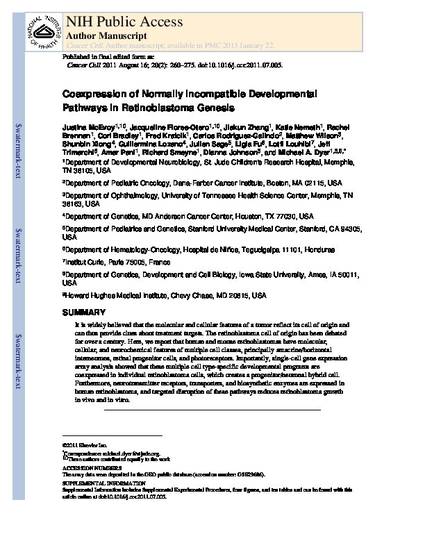
Article
Coexpression of Normally Incompatible Developmental Pathways in Retinoblastoma Genesis
Cancer Cell
Document Type
Article
Disciplines
Publication Version
Accepted Manuscript
Publication Date
1-1-2011
DOI
10.1016/j.ccr.2011.07.005
Abstract
It is widely believed that the molecular and cellular features of a tumor reflect its cell of origin and can thus provide clues about treatment targets. The retinoblastoma cell of origin has been debated for over a century. Here, we report that human and mouse retinoblastomas have molecular, cellular, and neurochemical features of multiple cell classes, principally amacrine/horizontal interneurons, retinal progenitor cells, and photoreceptors. Importantly, single-cell gene expression array analysis showed that these multiple cell type-specific developmental programs are coexpressed in individual retinoblastoma cells, which creates a progenitor/neuronal hybrid cell. Furthermore, neurotransmitter receptors, transporters, and biosynthetic enzymes are expressed in human retinoblastoma, and targeted disruption of these pathways reduces retinoblastoma growth in vivo and in vitro.
Copyright Owner
Elsevier Inc.
Copyright Date
2011
Language
en
File Format
application/pdf
Citation Information
Justina McEvoy, Jacqueline Flores-Otero, Jiakun Zhang, Katie Nemeth, et al.. "Coexpression of Normally Incompatible Developmental Pathways in Retinoblastoma Genesis" Cancer Cell Vol. 20 Iss. 2 (2011) p. 260 - 275 Available at: http://works.bepress.com/jeffrey-trimarchi/8/

This is a manuscript of an article from Cancer Cell 20 (2011): 260, doi: 10.1016/j.ccr.2011.07.005. Posted with permission.